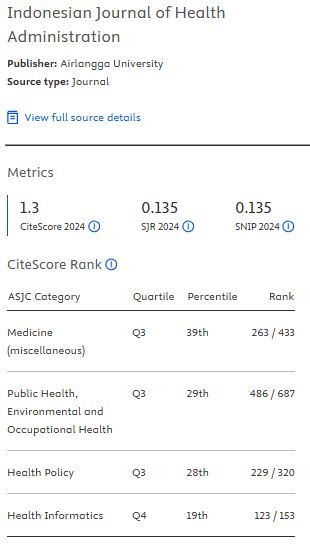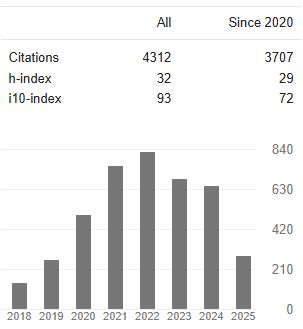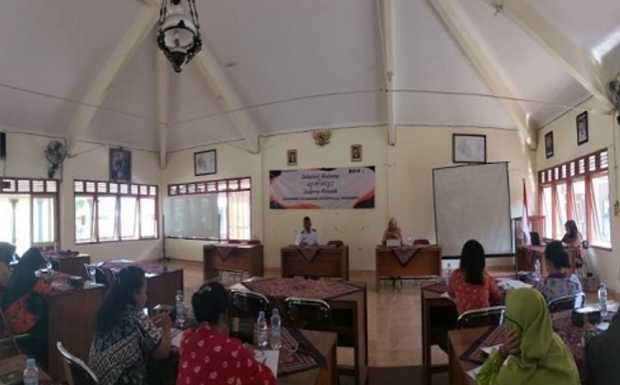REDUCING INFANT AND UNDER-5 MORTALITY RATE THROUGH GOVERNMENT HEALTH EXPENDITURE: A SYSTEMATIC REVIEW

Background: Although it has been globally reported that IMR and U5MR continue to decline every year, the rate disparities between urban and rural areas are still evident in various countries. The government is presumed to carry out efforts to reduce this disparity, such as by allocating the government's health expenditure.
Aims: This study systematically identifies the effectiveness, best practices, and positive impacts of government health expenditure allocation for IMR and U5MR, specifically in rural areas.
Methods: This systematic review study was conducted using the PICOS method to analyse data that were obtained from 3 online databases.
Results: The government health expenditure could reduce the gap in mortality rate indicators between urban and rural areas. Programs specifically proposed for rural communities can help decrease the gap between urban-rural IMR and U5MR. The effectiveness of government health expenditure to reduce mortality rates was strongly influenced by various factors, including supporting policies, field implementation in regions, and the collaboration between the central and local governments.
Conclusion: The local government plays a definitely crucial role in the implementation of the health program to ensure that the central government executes the program effectively in order to reduce IMR and U5MR in rural areas.
Adewuyi, E.O. and Zhao, Y. (2017) ‘Determinants of Neonatal Mortality in Rural and Urban Nigeria: Evidence from a Population-Based National Survey', Pediatrics International, 59(2), pp. 190–200. doi:10.1111/ped.13086.
Adsul, N. and Kar, M. (2013) ‘Study of rogi kalyan samitis in strengthening health systems under national rural health mission, district pune, maharashtra', Indian journal of community medicine : official publication of Indian Association of Preventive & Social Medicine, 38(4), pp. 223–228. doi:10.4103/0970-0218.120157.
Bruns, D.P., Pawloski, L. and Robinson, C. (2019) ‘Can Adoption of Cuban Maternity Care Policy Guide the Rural United States to Improve Maternal and Infant Mortality?', World Medical & Health Policy, 11(3), pp. 316–330. doi:10.1002/wmh3.312.
Chaudhary, S. et al. (2017) ‘Evaluation of Janani Shishu Suraksha Karyakram scheme and out of pocket expenditure in a rural area of Northern India.', Journal of family medicine and primary care, 6(3), pp. 477–481. doi:10.4103/2249-4863.222010.
Cochrane (2021) Cochrane Handbook for Systematic Reviews of Interventions version 6.2 (Updated February 2021). Edited by J. Higgins et al. Cochrane. Available at: www.training.cochrane.org/handbook.
Díaz, J.-J. and Saldarriaga, V. (2019) ‘Encouraging use of prenatal care through conditional cash transfers: Evidence from JUNTOS in Peru', Health Economics, 28(9), pp. 1099–1113. doi:10.1002/hec.3919.
Drummond, M.F. and Jefferson, T.O. (1996) ‘Guidelines for authors and peer reviewers of economic submissions to the BMJ. The BMJ Economic Evaluation Working Party.', BMJ (Clinical research ed.), 313(7052), pp. 275–283. doi:10.1136/bmj.313.7052.275.
Gopalakrishnan, S. and Immanuel, A.B. (2018) ‘Progress of health care in rural India: a critical review of National Rural Health Mission', International Journal of Community Medicine and Public Health, 5(1), pp. 4–4.
Gupta, M. et al. (2017) ‘Utilization of Intergovernmental Funds to Implement Maternal and Child Health Plans of a Multi-Strategy Community Intervention in Haryana, North India: A Retrospective Assessment.', PharmacoEconomics - open, 1(4), pp. 265–278. doi:10.1007/s41669-017-0026-3.
Houweling, T.A.J. et al. (2019) ‘The equity impact of community women's groups to reduce neonatal mortality: a meta-analysis of four cluster randomized trials', International Journal of Epidemiology, 48(1), pp. 168–182. doi:10.1093/ije/dyx160.
Huicho, L., Segura, E.R., et al. (2016) ‘Child health and nutrition in Peru within an antipoverty political agenda: a Countdown to 2015 country case study.', The Lancet. Global health, 4(6), pp. e414-26. doi:10.1016/S2214-109X(16)00085-1.
Huicho, L., Huayanay-Espinoza, C.A., et al. (2016) ‘Examining national and district-level trends in neonatal health in Peru through an equity lens: a success story driven by political will and societal advocacy', BMC Public Health, 16, pp. 103–117. doi:10.1186/s12889-016-3405-2.
Huicho, L., Huayanay-Espinoza, ⨯ Carlos A, et al. (2018) ‘Enabling reproductive, maternal, neonatal and child health interventions: Time trends and driving factors of health expenditure in the successful story of Peru', PLoS One, 13(10). doi:10.1371/journal.pone.0206455.
Huicho, L., Hernandez, P., et al. (2018) ‘Understanding drivers of domestic public expenditure on reproductive, maternal, neonatal and child health in Peru at district level: an ecological study', BMC Health Services Research, 18. doi:10.1186/s12913-018-3649-x.
Hyre, A. et al. (2019) ‘Expanding maternal and neonatal survival in Indonesia: a program overview', International Journal of Gynecology & Obstetrics, 144, pp. 7–12.
Jimenez Soto, E. et al. (2013) ‘Investment case for improving maternal and child health: results from four countries.', BMC public health, 13, pp. 601–601. doi:10.1186/1471-2458-13-601.
Karki, B.K. and Kittel, G. (2019) ‘Neonatal mortality and child health in a remote rural area in Nepal : a mixed methods study', BMJ Paediatrics Open [Preprint]. doi:10.1136/bmjpo-2019-000519.
Kementerian PPN/Bappenas and UNICEF (2017) Laporan Baseline SDG tentang Anak-Anak di Indonesia. Jakarta. Available at: https://www.unicef.org/indonesia/sites/unicef.org.indonesia/files/2019-06/SDG_Baseline_report Indonesian.pdf.
Li, J. and Yuan, B. (2019) ‘Understanding the effectiveness of government health expenditure in improving health equity: Preliminary evidence from global health expenditure and child mortality rate.', The International journal of health planning and management, 34(4), pp. e1968–e1979. doi:10.1002/hpm.2837.
Mukhopadhyay, D.K. et al. (2018) ‘Exploring the Bottlenecks: An Assessment of the Implementation Process of Janani Suraksha Yojana in the State of West Bengal, India', International Journal of Medicine and Public Health, 8(1), pp. 29–33. doi:10.5530/ijmedph.2018.1.6.
Nongdrenkhomba, H.N. et al. (2015) ‘Local governance system for management of public health facilities: Functioning of Rogi Kalyan Samiti in North Eastern States of India', South East Asia Journal of Public Health, 4(2), pp. 16–22. doi:10.3329/seajph.v4i2.23690.
Nyqvist, M.B. et al. (2019) ‘Reducing child mortality in the last mile: Experimental evidence on community health promoters in Uganda', American Economic Journal: Applied Economics, 11(3), pp. 155–192. doi:10.1257/app.20170201.
Pandey, A. and Mohan, A. (2019) ‘The role of national rural health mission in reducing infant mortality rate in India', International Journal of Health Governance, 24(1), pp. 56–65. doi:10.1108/IJHG-09-2018-0044.
Patra, S.K., Murthy, D.S. and Rath, S. (2013) ‘An Evaluation of the National Rural Health Mission (NRHM) in Odisha', Journal of Health Management, 15(3), pp. 471–480. doi:10.1177/0972063413491880.
Pedrana, A. et al. (2019) ‘Assessing the effect of the Expanding Maternal and Neonatal Survival program on improving stabilization and referral for maternal and newborn complications in Indonesia', International Journal of Gynecology and Obstetrics, 144, pp. 30–41. doi:10.1002/ijgo.12733.
Pulkki-Brännström, A.-M. et al. (2020) ‘Participatory learning and action cycles with women s groups to prevent neonatal death in low-resource settings: A multi-country comparison of cost-effectiveness and affordability.', Health policy and planning [Preprint]. doi:10.1093/heapol/czaa081.
Russo, L.X. et al. (2019) ‘Primary care physicians and infant mortality: Evidence from Brazil', PLOS ONE, 14(5), pp. e0217614–e0217614. Available at: https://doi.org/10.1371/journal.pone.0217614.
Servan-Mori, E. et al. (2016) ‘A Performance Analysis of Public Expenditure on Maternal Health in Mexico', PLoS One, 11(4). doi:10.1371/journal.pone.0152635.
Walker, D. et al. (2020) ‘Effect of a quality improvement package for intrapartum and immediate newborn care on fresh stillbirth and neonatal mortality among preterm and low-birthweight babies in Kenya and Uganda: a cluster-randomised facility-based trial', The Lancet Global Health, 8(8), pp. e1061–e1070. doi:10.1016/S2214-109X(20)30232-1.
Wang, S. and Wu, J. (2020) ‘Spatial heterogeneity of the associations of economic and health care factors with infant mortality in China using geographically weighted regression and spatial clustering.', Social science & medicine (1982), 263, pp. 113287–113287. doi:10.1016/j.socscimed.2020.113287.
Wang, Y. et al. (2012) ‘Geographical disparities of infant mortality in rural China', Archives of Disease in Childhood-Fetal and Neonatal Edition, 97(4), pp. F285–F290.
Copyright (c) 2022 Alissa Sita Pertiwi, Amal Chalik Sjaaf

This work is licensed under a Creative Commons Attribution-ShareAlike 4.0 International License.
1. As an author you (or your employer or institution) may do the following:
- make copies (print or electronic) of the article for your own personal use, including for your own classroom teaching use;
- make copies and distribute such copies (including through e-mail) of the article to research colleagues, for the personal use by such colleagues (but not commercially or systematically, e.g. via an e-mail list or list server);
- present the article at a meeting or conference and to distribute copies of the article to the delegates attending such meeting;
- for your employer, if the article is a ‘work for hire', made within the scope of your employment, your employer may use all or part of the information in the article for other intra-company use (e.g. training);
- retain patent and trademark rights and rights to any process, procedure, or article of manufacture described in the article;
- include the article in full or in part in a thesis or dissertation (provided that this is not to be published commercially);
- use the article or any part thereof in a printed compilation of your works, such as collected writings or lecture notes (subsequent to publication of the article in the journal); and prepare other derivative works, to extend the article into book-length form, or to otherwise re-use portions or excerpts in other works, with full acknowledgement of its original publication in the journal;
- may reproduce or authorize others to reproduce the article, material extracted from the article, or derivative works for the author's personal use or for company use, provided that the source and the copyright notice are indicated.
All copies, print or electronic, or other use of the paper or article must include the appropriate bibliographic citation for the article's publication in the journal.
2. Requests from third parties
Although authors are permitted to re-use all or portions of the article in other works, this does not include granting third-party requests for reprinting, republishing, or other types of re-use.
3. Author Online Use
- Personal Servers. Authors and/or their employers shall have the right to post the accepted version of articles pre-print version of the article, or revised personal version of the final text of the article (to reflect changes made in the peer review and editing process) on their own personal servers or the servers of their institutions or employers without permission from JAKI;
- Classroom or Internal Training Use. An author is expressly permitted to post any portion of the accepted version of his/her own articles on the author's personal web site or the servers of the author's institution or company in connection with the author's teaching, training, or work responsibilities, provided that the appropriate copyright, credit, and reuse notices appear prominently with the posted material. Examples of permitted uses are lecture materials, course packs, e-reserves, conference presentations, or in-house training courses;























